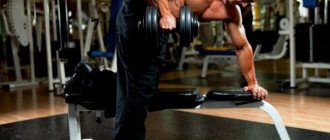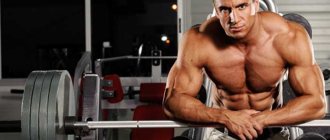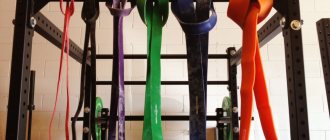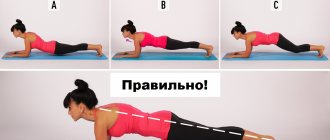It is no longer a secret to anyone that it is the duration of the muscles being under load during a set of strength exercises that determines the subsequent scale of hypertrophy. By scale here, in particular, we mean the number of muscle fibers in which protein synthesis will be launched. We all understand perfectly well that it is the weight of the weight used that determines the duration of the load. The closer the weight is to the maximum, the faster failure is achieved, the shorter the time the muscle is under load, and vice versa. Despite the fact that there is a certain middle ground, any work with large, medium or small weights has its advantages. Bodybuilding, as a training system, in the process of its evolution, empirically established not only the optimal weights for hypertrophy, but also developed a number of methods that allow you to combine the advantages of working with large, medium and even small weights within the framework of performing one exercise. I have already talked about some of them in earlier publications, in particular the rest-pause and striptease training methods. But there is another similar method that also deserves some attention.
Forced reps
We are talking about the method of forced repetitions. Forced reps are performing an additional 1-3 repetitions of an exercise with the help of a partner after reaching failure. In other words, you, for example, have reached a positive failure in the bench press, but continue to lower the weight onto your chest and press it again, but with the help of a partner who, by applying the minimum possible muscular effort to the bar, helps, as it were, remove part of the load from the bar . Thus, you can perform one or a couple more repetitions in addition to the main approach, thereby increasing the duration of the exercise. Since the load in these repetitions is reduced compared to the main weight, this method is very similar to the striptease method. However, if in “striptease” you can reduce the weight of the weight by almost any amount, then in forced repetitions this value is limited, firstly, by the force applied to the projectile by the partner, and secondly, by the very essence of this method, that is, the partner’s help should be minimum possible. As a result, “striptease” allows you to perform dozens of additional repetitions, and forced repetitions should be no more than three, and even more often - two. From the point of view of sports adaptology, the method of forced repetitions is much more gentle in terms of the risk of excessive acidification of muscle cells with hydrogen ions, however, it is quite effective because it allows you to extend the time the muscle is under load, which is especially important when working with large weights, which means low number of repetitions. In this regard, this method is most advisable to use in cases where the approach does not last long and fits into 5–8 repetitions. With a load that allows you to do 12 or more repetitions, the return from forced repetitions decreases, since the muscles have already received the optimal stimulus and have accumulated the proper amount of growth factors. Thus, we can say that the main type of muscle fibers that are stressed when using the forced repetition method, in the case of performing 5-8 main repetitions in the approach, are glycolytic, which predominate among bodybuilders.
Muscle growth has stopped? Do forced reps
Forced reps are a technique from the “golden era” of bodybuilding. Nowadays it is quite rarely used in its original form.
Yes, in commercial fitness clubs you will almost never see a couple of strong guys working out together. Usually, people either work with a trainer who protects them from injury and does not teach them potentially dangerous techniques, or they go alone and practice as hard as they can. The conquerors of Olympia of previous years were not like that. And in the basements they know very well that in order to grow, you need to work “to failure”, and it must be real.
Attention: if you are a beginner whose technique is not “very good” yet, work on your technique. This will help you gain muscle mass faster than you think. As long as you practice the correct mechanics of movement, you will receive enough incentives for growth.
Forced reps are performing 2-3 reps after failure with the help of a partner. Obviously, you will need a good belayer, dedication and the ability to work “in failure”. The technique should be used if:
- A strength plateau has been reached;
- The athlete is on a mass gain with appropriate nutrition;
- He maintains a routine, approaches training fresh, and does not get distracted;
- The technique of the exercise in which forced repetition will be performed is close to ideal
Until the plateau is reached, it makes no sense to “pressure” yourself with forced repetitions.
Techniques for increasing intensity and volume are only good if the athlete has already exhausted the usual methods of self-improvement. Otherwise, they are applied too early and can lead to injury and overtraining.
Important: the club's coach on duty may not be suitable as a belayer. Use the help of trusted people.
How to do forced reps using the bench press as an example:
- Hang your usual weight on the bar for 10 reps;
- Work independently to failure;
- Ask the spotter to help you do 2-3 more repetitions;
- The belayer should not “pull” the weight too much; assistance is required by about 20-30%, no more;
- Complete the set and rest
There is an opinion that forced repetitions should be used in all approaches. But for most natural athletes with normal recovery abilities, this is not true. Just one final approach is enough to feel the full power of this technique.
Should I do forced reps on all exercises in my workout? Let's say you're doing bench presses, French triceps presses, and dumbbell crunches. You can perform one forced set of each exercise.
Experienced athletes can afford 3 presses to failure with forced repetitions.
Do you need to include several of these sets in your workout? Depends on the speed of recovery. Most natural lifters can't do this simply because they don't complete their 10 reps with the same weight. Resetting the scales does not make sense, since this significantly affects the process of creating incentives for growth.
How many forced reps can you add to your plan? Typically, athletes specialize in 1-2 muscle groups that lag behind during the training process. You should not do forced repetitions on both groups at once if you have two of them. This can cause overtraining. You need to understand that too active use of the body’s internal resources is not the best option. Building quality mass requires not only good loads, but also complete recovery. That is why it is important to use the technique in moderation.
Can you combine forced reps with drop sets? Yes, if we are talking about an experienced athlete and drop sets on an isolated muscle. And of course, you shouldn’t combine them if you’re a beginner.
Forced reps should not be used in strength-building plans. It’s a paradox, but this works better for hypertrophy rather than strength. Such techniques tire the athlete's nervous system and can lead to problems with recovery.
Forced repetitions are just one technique for increasing the intensity and volume of training. They should be used when the classical linear and wave-like periodization of the load has exhausted itself. This doesn't mean you have to do the work "after failure" every workout. With legs and back, it makes sense to do such a series once every 2 weeks if the athlete trains without pharmaceutical support. Lightweights can recover faster and can do these types of workouts more often.
When used correctly and carefully, forced reps help break through plateaus in mass gain and provide ample stimulus for growth. To use this technique, you need good technique, adequate recovery and proper nutrition, plus proper load distribution.
What exercises can you use the forced repetition method for?
First of all, these are various variations of seated and lying presses for developing the muscles of the chest, triceps and shoulders, performed with a barbell or dumbbells, in the Smith machine or other lever and block type exercise machines. In addition, forced repetitions can be performed in back exercises such as lat pulldowns, Nautilus rows, and pull-ups. In leg training, this could be squats with a barbell with free weight or in the Smith Machine, leg presses, hack squats.
Insurer
If you train long enough, you will eventually reach a point where you need to have a spotter for a number of exercises, including squats and bench presses. There's nothing wrong with that - it's a sign that you're pushing yourself to the limit, which is a good thing as long as it's not exaggerated. However, when you are working hard, the belayer must be experienced. A good spotter should watch every part of the exercise, sometimes pretending to hold the weight and help you complete the required number of repetitions, but not apply force until the critical moment. During squats or belaying by the elbows, a light touch from the belayer instills confidence and gives you strength, while you do the seemingly impossible. A good belayer must be strong, attentive and constantly ready for any turn of events - not look around, or joke with friends.
Experienced partner
It is very important that the partner is experienced. His help should really be minimal. Sometimes you have to watch how a partner who is belaying a bench press, instead of applying force to the bar with his fingertips, actually performs a full deadlift, completely removing the load from the bencher. This is no good, and such help will not bring any benefit. In addition, it is important that in bench press exercises with free weights, the partner does not disrupt the natural trajectory of the apparatus with his help, which can lead to injury.
Features of the technique
Each approach in the training process should end hard. When the muscles already “refuse” to work, the time comes to force the load. Forced repetitions are recommended to be performed only in the last approach of the basic exercise, as they deplete the nervous system. The higher the number of repetitions, the more emphasis is placed on developing endurance rather than strength.
Most often this technique is used in bench press exercises:
- bench press;
- seated press;
- standing press
In the dumbbell bench press, for example, your partner helps you press the weight by pushing your elbows from below, but the help should be minimal so that you can press the weight to the end yourself.
If you can't get a partner, you can help yourself perform forced reps. Do the exercises unilaterally, while helping yourself with the other limb. For example, when doing a press with one leg, support the moving platform with the other.
Let us summarize the basic principles of forced approaches:
- The exercise is performed when the muscle has reached the limit of fatigue.
- Before starting the set, you need to agree with your partner on the number of joint presses to perform and the degree of his assistance.
- This technique should not be used for all workouts.
- It is recommended to alternate forced repetitions for different muscle groups after 1-2 sessions.
Frequency of application
This method can be used relatively frequently as it does not create excessive acidification. This circumstance allows us to recommend it for “naturals”, but it should be understood that the degree of acidification of muscle fibers still increases significantly, which means that the rest time between approaches should also be increased. Otherwise, the next approach will be less productive, since the number of repetitions in it may significantly decrease compared to the previous approach. For this reason, it is recommended to perform forced repetitions not on every set of the exercise, but only on the last one. This can be considered the optimal amount of forced load for a workout - the last set of each exercise.
Attention: Materials posted in this section may be published in whole or in part only with the obligatory indication of the source of the publication.
What is the essence of the method?
Forced reps have several features that make the vehicle unique, let's talk about them:
- exercises are performed in sets, with the participation of an assistant; this role can be played by a coach, friend or casual acquaintance;
- repetitions are started when the athlete can no longer perform a set on his own:
- but practicing the technique in every lesson, resorting to support or an assistant is not recommended.
When muscle fibers harden, and a person cannot fully complete a set, but still wants to continue the exercise. He should resort to forced exercises.
! The execution technique is not particularly complicated; the “assistant” should not take on the main burden. Its task is to provide assistance allowing you to continue training.
So what are these Forced reps? At its core, it is support that allows you to increase the effectiveness of your training to a certain extent.
How the lesson plan works:
- In the gym, a person performs certain body movements, lifts equipment.
- Since the loads are of a forceful nature, the athlete gets tired.
- At this moment, he has 2 options: he can stop the activity, stop, or resort to the help of a partner.
- The assistant provides all possible support, preventing the person from dropping the projectile or getting damaged.
This technique, to a greater extent, trains endurance; it “forces” a person to continue training when he no longer has the strength. The feeling that it will be easier further does not allow the athlete to stop.
What exercises can be done this way?
The technique is suitable for strength training, mainly those exercises that are performed with weights. That is, dumbbells or a barbell are involved in the process.
We are talking about bench presses while standing, sitting or performing the exercise in a lying position. However, the presence of an assistant is not considered mandatory. A person can help himself, provided that he performs the exercise with one limb.
How to do without an assistant:
- you can support one hand and perform the exercise with the other;
- similar manipulations should be repeated with the leg.
If a platform is involved in the training process, then the exercise is performed with one limb, and the other supports it.









